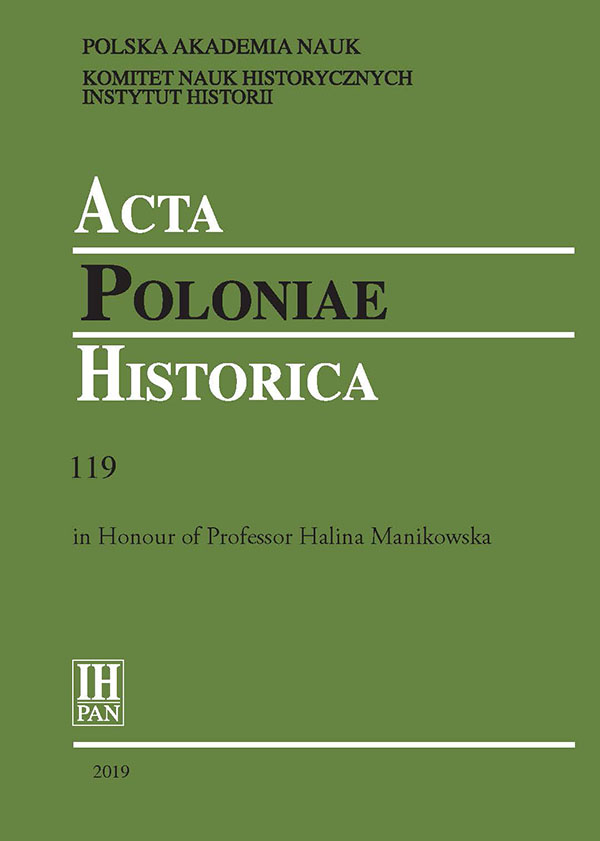Quarters in the Municipal Authority System in Late Medieval Prussian Towns
DOI:
https://doi.org/10.12775/APH.2019.119.10Keywords
urban history, Prussian towns, urban space, urban community, late medieval towns and citiesAbstract
The article seeks to comparatively analyse the functions implemented in the Late Middle Ages by quarters in the main towns or cities of Prussia, including Rechtstadt Danzig (Main City of Gdańsk), Altstadt Königsberg (Old Town of Königsberg [today Kaliningrad]), Braunsberg (Braniewo), Altstadt Thorn (Toruń), and Kulm (Chełmno). Special attention is placed on answering the question of how the quarters participated in the municipal authority structures and the relationships between town councils and the commons. Quarters in Prussian towns developed since the fifteenth century, somewhat later than in East Central European towns. Establishment of these units was based on several premises: organisation of fiscal accountancy, fire safety concerns, military purposes, and town councils’ strivings to reinforce control over the dwellers. Influenced by the city revolts at the beginning of the fifteenth and in the sixteenth century, town councils took efforts to create a system of mobilisation and communication with the inhabitants that would work without the intermediation of guilds (as in Elbing [Elbląg], Danzig, and Thorn). Subordination of the older quarters to the municipal authorities caused, moreover, that in the face of internal or external threat, the community appeared as a community ruled by town councillors.
References
Benders Jeroen F., ‘Nachbarn und Behörde. Formen und Funktionen von Vierteln und Nachbarschaften in spätmittelalterlichen und frühneuzeitlichen Städten im Osten und Norden der Niederlande anhand der Fälle Zutphen und Groningen’, in Hanno Brand, Sven Rabeler, and Harm von Seggern (eds.), Gelebte Normen im urbanen Raum. Zur sozial- und kulturgeschichtlichen Analyse rechtlicher Quellen in Städten des Hanseraumes (13. bis 16. Jahrhundert) (Hilversum, 2014), 129–48.
Bogucka Maria, ‘Przemiany społeczne i walki społeczno-polityczne w XV i XVI w.’, in Edmund Cieślak (ed.), Historia Gdańska, ii: 1454–1655 (Gdańsk, 1982), 208–59
Buława Józef, Walki społeczno-ustrojowe w Toruniu w I połowie XVI wieku (Toruń, 1971).
Goliński Mateusz, ‘Wokół przemian przestrzennych polokacyjnego Wrocławia’, in Jerzy Rozpędowski (ed.), Architektura Wrocławia, ii: Urbanistyka (Wrocław, 1995), 29–40.
Jütte Robert, ‘Das Stadtviertel als Problem und Gegenstand der frühneuzeitlichen Geschichtsforschung’, Blätter für deutsche Landesgeschichte, cxxvii (1991), 235–60.
Manikowska Halina, ‘Miasta i mieszczaństwo na ziemiach Polski w średniowieczu – postulaty i perspektywy badawcze’, in Wojciech Fałkowski (ed.), Pytania o średniowiecze. Potrzeby i perspektywy badawcze polskiej mediewistyki (Warszawa, 2001), 99–127.
Nowak Zenon Hubert, ‘Przyczynek do układu przestrzennego średniowiecznego Chełmna’, in Sławomir Kalembka et al. (eds.), Historia i archiwistyka. Księga pamiątkowa ku czci profesora Andrzeja Tomczaka (Toruń, 1992), 309–14.
Opll Ferdinand, Alte Grenzen im Wiener Raum, Kommentare zum Historischen Atlas von Wien, 4 (Wien, 1986).
Opll Ferdinand, ‘Wien – nach Köln eine der bedeutendsten Städte des Regnum Theutonicum. Ein Städtevergleich’, in Wilhelm Janssen and Margret Wensky (eds.), Mitteleuropäisches Städtewesen in Mittelalter und Frühneuzeit. Edith Ennen gewidmet (Köln, Weimar and Wien, 1999), 63–89.
Quassowski Bertha, ‘Obrigkeitliche Wohlfahrtspflege in den Hansestädten des Deutschordenslandes (Braunsberg, Elbing, Königsberg, Kulm und Thorn) bis 1525’, ii, Zeitschrift des Westpreußischen Geschichtsvereins, lx (1921), 27–66.
Reitemeier Arnd, ‘Kirchspiele und Viertel als “vertikale Einheiten” der Stadt des späten Mittelalters’, Blätter für deutsche Landesgeschichte, cxli/cxlii (2005/2006), 603–40.
Semrau Artur, ‘Die Register über die Bewachung der Altstadt Elbing aus dem 15. Jahrhundert’, Mitteilungen des Coppernicus Vereins für Wissenschaft und Kunst zu Thorn, 29 (1921), 50–61.
Simson Paul, Geschichte der Stadt Danzig, i (Danzig, 1913).
Starzyński Marcin, Das mittelalterliche Krakau. Der Stadtrat im Herrschaftsgefüge der polnischen Metropole (Köln, Weimar and Wien, 2015), Städteforschung, Reihe A: Darstellungen 92.
Toeppen Max, ‘Das Elbinger Kriegsbuch’, in Altpreussische Monatsschrift, 36, 2 (1899), 223–73.
Zieliński Marek Grzegorz, Chełmno civitas totius Prussiae metropolis XVI–XVIII w. (Bydgoszcz, 2007).
Zins Henryk, ‘Rewolta w Elblągu w 1525 r.’, Zapiski Historyczne, xxii, 4 (1956), 7–50.
Downloads
Published
How to Cite
Issue
Section
License
Title, logo and layout of journal are reserved trademarks of APH.Stats
Number of views and downloads: 423
Number of citations: 1



